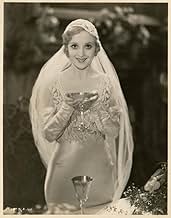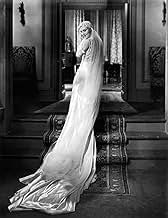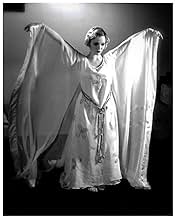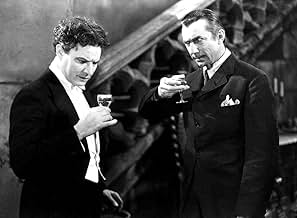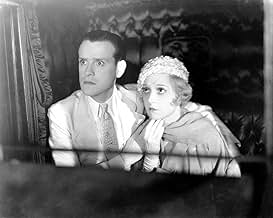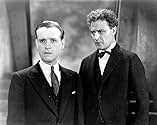PUNTUACIÓN EN IMDb
6,2/10
12 mil
TU PUNTUACIÓN
Un joven recurre a un médico brujo para alejar a la mujer que ama de su prometido, pero en cambio la convierte en una esclava zombie.Un joven recurre a un médico brujo para alejar a la mujer que ama de su prometido, pero en cambio la convierte en una esclava zombie.Un joven recurre a un médico brujo para alejar a la mujer que ama de su prometido, pero en cambio la convierte en una esclava zombie.
- Dirección
- Guión
- Reparto principal
John T. Prince
- Ledot - Zombie
- (as John Printz)
Clarence Muse
- Coach Driver
- (sin acreditar)
Reseñas destacadas
A couple of years ago I saw the 1931 version of Dracula as part of a live performance for the new musical score composed by Philip Glass. Even in this refined setting, the film was met by laughter from the audience during several sections. This seemed rather odd to me, but I suppose older horror films cannot help but lose some of their initial impact over time. The black and white photography and performance techniques became antiquated, hence humorous to some. As time went on, filmmakers begin to spoof the broad overacting and dramatic music of the vintage horror picture. It is impossible today to view a film like WHITE ZOMBIE and fully understand the impact it may have had in 1932. It does, however, escape (for the most part anyway) the mirthful reactions described above.
Director Victor Halprin's telling of this tale is often cited as the genesis of the "zombie picture." There is some debate about this, but WHITE ZOMBIE is certainly one of the early films to deal with the Haitian legend of "the dead that walk." The story revolves around a young couple who have traveled through Haiti to meet with their friend and benefactor Charles Beaumont (Robert Frazer), at whose villa they plan to be married. He has designs on the young bride, Madeleine (Madge Bellamy), and enlists the help of Murder Legendre (the name kind of says it all) played by Bela Lugosi. After the wedding, Legendre performs some "witchcraft" rituals and Madeleine falls into a death-like state. Believing that she has in fact died, the newly minted groom (John Harron) spirals into a drunken maelstrom, eventually seeking out the learned missionary Dr. Bruner (Joseph Cawthorn) to help solve the mystery. All paths seem to lead back to Legendre as the plot thickens and Beaumont's true motives are discovered.
It is fascinating to watch these type of films, some of which, like WHITE ZOMBIE age well with time. This is partly due to the fact that it has been largely forgotten in the wake of the more successful Universal horror flicks. The main drawn here will be the performance by Lugosi. He essentially "vamps" his role in Dracula, but manages to fashion a fairly distinct and unsettling screen presence. It would be roles like this however that would lead to his rigid typecasting; as time went on, he was all but discarded by the film industry (see ED WOOD [1994] for his later years). Halprin's direction focuses on atmosphere and gloom. He is well paired with cinematographer Arthur Martinelli and together they create a suitably shadow-laden backdrop for this macabre story. WHITE ZOMBIE is ambitious in camera angles and editing. At one point there is a diagonal wipe edit, which stops midscreen to reveal the actions of two separate characters. This type of effect is effortless to achieve now, but must have been laborious in 1932. Observe also the unusually large transitional set of the plantation interior, or the framing of Lugosi though the ornate stone work during certain shots. These small details help set WHITE ZOMBIE apart by creating a realistic environment and aid in visually representing the pathology of the characters.
Since the 30's there has been countless movies about killer zombies run amuck. The concept predominantly became fodder for B-grade schlock productions. The genre would experience something of a renaissance in 1968 with George Romero's NIGHT OF THE LIVING DEAD which created quite a stir at the time and resulted in zombies becoming, once again, fashionable. The Haitian setting of WHITE ZOMBIE would also be revisited in THE SERPENT AND THE RAINBOW (1988) and the "undead" as a means of cheap labor subtext would be exploited for darkly comedic effect in the underrated HBO film CAST A DEADLY SPELL (1991). In recent years, there has been such a boom of these "living dead" productions that it is hard to keep track of them all. WHITE ZOMBIE, as an early example of this current trend, but should be seen as more than just a footnote in the ever growing history of film. It is not a great movie, like Dracula, but will prove to be of interest to film buffs at least. It has more to offer, though, and I hope that it will continue to be rediscovered by successive generations. 7/10
Director Victor Halprin's telling of this tale is often cited as the genesis of the "zombie picture." There is some debate about this, but WHITE ZOMBIE is certainly one of the early films to deal with the Haitian legend of "the dead that walk." The story revolves around a young couple who have traveled through Haiti to meet with their friend and benefactor Charles Beaumont (Robert Frazer), at whose villa they plan to be married. He has designs on the young bride, Madeleine (Madge Bellamy), and enlists the help of Murder Legendre (the name kind of says it all) played by Bela Lugosi. After the wedding, Legendre performs some "witchcraft" rituals and Madeleine falls into a death-like state. Believing that she has in fact died, the newly minted groom (John Harron) spirals into a drunken maelstrom, eventually seeking out the learned missionary Dr. Bruner (Joseph Cawthorn) to help solve the mystery. All paths seem to lead back to Legendre as the plot thickens and Beaumont's true motives are discovered.
It is fascinating to watch these type of films, some of which, like WHITE ZOMBIE age well with time. This is partly due to the fact that it has been largely forgotten in the wake of the more successful Universal horror flicks. The main drawn here will be the performance by Lugosi. He essentially "vamps" his role in Dracula, but manages to fashion a fairly distinct and unsettling screen presence. It would be roles like this however that would lead to his rigid typecasting; as time went on, he was all but discarded by the film industry (see ED WOOD [1994] for his later years). Halprin's direction focuses on atmosphere and gloom. He is well paired with cinematographer Arthur Martinelli and together they create a suitably shadow-laden backdrop for this macabre story. WHITE ZOMBIE is ambitious in camera angles and editing. At one point there is a diagonal wipe edit, which stops midscreen to reveal the actions of two separate characters. This type of effect is effortless to achieve now, but must have been laborious in 1932. Observe also the unusually large transitional set of the plantation interior, or the framing of Lugosi though the ornate stone work during certain shots. These small details help set WHITE ZOMBIE apart by creating a realistic environment and aid in visually representing the pathology of the characters.
Since the 30's there has been countless movies about killer zombies run amuck. The concept predominantly became fodder for B-grade schlock productions. The genre would experience something of a renaissance in 1968 with George Romero's NIGHT OF THE LIVING DEAD which created quite a stir at the time and resulted in zombies becoming, once again, fashionable. The Haitian setting of WHITE ZOMBIE would also be revisited in THE SERPENT AND THE RAINBOW (1988) and the "undead" as a means of cheap labor subtext would be exploited for darkly comedic effect in the underrated HBO film CAST A DEADLY SPELL (1991). In recent years, there has been such a boom of these "living dead" productions that it is hard to keep track of them all. WHITE ZOMBIE, as an early example of this current trend, but should be seen as more than just a footnote in the ever growing history of film. It is not a great movie, like Dracula, but will prove to be of interest to film buffs at least. It has more to offer, though, and I hope that it will continue to be rediscovered by successive generations. 7/10
Sometimes silly, sometimes stilted, nearly always stagey, White Zombie remains nonetheless one of the most visually fascinating films in horror history. Who can forget the image of Madge Bellamy's alabaster gown flowing down the concrete staircase, or the zombie burial procession outlined spectrally against the sky, or the sinister shadows cast demonically across a dance floor. Then there's the magnificently Gothic hall with its grotesquely twisted bannister like none other I've seen. In fact, almost every scene presents at least one arresting visual feature. As good as these and the many other touches are, it's still the mill scene that remains a masterpiece of visual staging. It must be seen to be appreciated-- the pitiless grind of the crusher, the soundless shuffle circling into the maw-- all in all, one of the deeper levels of Dante's inferno and one that's bound to stay with you.
If the visuals are inspired, the acting is not. It's almost as if two different people are in charge. Bellamy is quite good with her large liquid eyes and bee-stung lips. Her transformation into a zombie stupor is well performed. Of course, there's also Lugosi as Lugosi, florid, hammy, but effective nonetheless. The other principals, however, bring down the proceedings with what can only be described as bad acting. Bellamy's swain in particular is plain annoying, while the preacher appears to have wandered in from a breezy Bing Crosby production. Too bad. With more appropriate performances this could have been an all-time classic.
As things stand, it's a truly memorable film, whose influence can be seen in such diverse venues as Val Lewton's horror cycle, Bergman's The Seventh Seal, and Romero's Night of the Living Dead. Except for the mill scene with its eerily grinding tonality, the movie might be best enjoyed by turning off the sound altogether. (P. S. Colorizing this b&w marvel is nothing less than a crime.)
If the visuals are inspired, the acting is not. It's almost as if two different people are in charge. Bellamy is quite good with her large liquid eyes and bee-stung lips. Her transformation into a zombie stupor is well performed. Of course, there's also Lugosi as Lugosi, florid, hammy, but effective nonetheless. The other principals, however, bring down the proceedings with what can only be described as bad acting. Bellamy's swain in particular is plain annoying, while the preacher appears to have wandered in from a breezy Bing Crosby production. Too bad. With more appropriate performances this could have been an all-time classic.
As things stand, it's a truly memorable film, whose influence can be seen in such diverse venues as Val Lewton's horror cycle, Bergman's The Seventh Seal, and Romero's Night of the Living Dead. Except for the mill scene with its eerily grinding tonality, the movie might be best enjoyed by turning off the sound altogether. (P. S. Colorizing this b&w marvel is nothing less than a crime.)
This review will be more about the print and theatrical experience than about the plot. Most people won't find this "useful", but hey, so what. Here's my two cents.
If you have the opportunity to see the Roan Group print projected in a theater, don't hesitate. Go see it.
I just saw this in the big screen last weekend and it is MUCH better in a proper theater with a crowd of enthusiasts than in the confines of your home, even with a big TV and 5.1. The audience I was in was comprised of about 150 kids and their parents. The kids had a great time as did I, who has seen the movie several times over the years in the washed out public domain video prints that have circulated forever.
The Roan Group print (same as the remastered DVD) is the one we saw, projected in 35 mm. It was obvious that there were two sources for this print. The vast majority of this appears to come from a very nice print with high contrast and sharp definition. The "fill-in" portions, apparently missing from the other source, are much more typical of a 75-year-old cheapie independent production shot in 11 days, i.e., scratchy, multiple generations removed from the negative, and faded. Thankfully there's not too much from that second source. There are a few jumps in the film (a few seconds at most) that could not be restored. Too bad, but no biggie.
The sound was problematic, veering from a comfortable volume when dialogue was speaking, to way too loud, almost to the point of distortion, when the music played or the bird squawked. I really don't think it was the theater's fault as their sound is always "just right".
Interestingly, for a movie this old (pre King Kong and Bride of Frankenstein) there was a whole lot of music and not as much dialogue as one usually gets in a film from this era. The music was rarely background to dialogue and was used almost exclusively to enhance the mood of the film. It was probably cheaper to do it this way, but who cares why. It works.
This is a really neat film full of great shots and creepy characters. Bela is fantastic, maybe his best performance on film. White Zombie hardly ranks up there with the Universal classics of the era, but it is positively time for a historical and critical reappraisal of this newly restored film.
It's good on video, but on the big screen, WOW!
If you have the opportunity to see the Roan Group print projected in a theater, don't hesitate. Go see it.
I just saw this in the big screen last weekend and it is MUCH better in a proper theater with a crowd of enthusiasts than in the confines of your home, even with a big TV and 5.1. The audience I was in was comprised of about 150 kids and their parents. The kids had a great time as did I, who has seen the movie several times over the years in the washed out public domain video prints that have circulated forever.
The Roan Group print (same as the remastered DVD) is the one we saw, projected in 35 mm. It was obvious that there were two sources for this print. The vast majority of this appears to come from a very nice print with high contrast and sharp definition. The "fill-in" portions, apparently missing from the other source, are much more typical of a 75-year-old cheapie independent production shot in 11 days, i.e., scratchy, multiple generations removed from the negative, and faded. Thankfully there's not too much from that second source. There are a few jumps in the film (a few seconds at most) that could not be restored. Too bad, but no biggie.
The sound was problematic, veering from a comfortable volume when dialogue was speaking, to way too loud, almost to the point of distortion, when the music played or the bird squawked. I really don't think it was the theater's fault as their sound is always "just right".
Interestingly, for a movie this old (pre King Kong and Bride of Frankenstein) there was a whole lot of music and not as much dialogue as one usually gets in a film from this era. The music was rarely background to dialogue and was used almost exclusively to enhance the mood of the film. It was probably cheaper to do it this way, but who cares why. It works.
This is a really neat film full of great shots and creepy characters. Bela is fantastic, maybe his best performance on film. White Zombie hardly ranks up there with the Universal classics of the era, but it is positively time for a historical and critical reappraisal of this newly restored film.
It's good on video, but on the big screen, WOW!
Zombie movies from the '30's and '40's are quite different from the zombie movies most people know from the '70's till present time. In the '30's and '40's, zombies and voodoo kind of rituals always walked hand in hand. As a result of this zombie movies from the '30's and '40's have a certain creepy atmosphere and scary voodoo sound effects.
"White Zombie" is the very first (still excising) zombie movie ever made. The zombies look extremely good and creepy thanks to the charismatic actors that perform them. Don't underestimate this people, acting with just your body and mostly face is also a form of tough acting. I think that it is thanks to the fine casting of the zombies that most of the scene's with them in it, work really well.
Bela Lugosi is totally fantastic as sort of witch doctor and 'king of the zombies'. He plays one scary monsieur. I even tend to say that this is his best villain role he has ever portrayed, yes even better as Count Dracula. Lugosi was always at his best in roles like these and just like in "Dracula" he is once more acting very well with also both his hands and face, especially his typical horror-like-eyes make him one legendary villain. For the Lugosi fans this is an absolute must see!
The story is very intriguing and sad and its told in a beautiful way. Especially the ending was fantastic and actually also quite tense.
Unfortunately time has not been kind on this movie. The movie had been lost for many years until the '60's after acquiring the rights to distribute the movie, the quality was already beyond restoration, so now days we can never watch this movie in its full glory. The movie has the grainy and visual look of movies from the 1920's and at times small chunks of sound and music are missing.
The cinematography is absolutely fantastic and the experimental editing provides some unique and extremely well looking sequences. It reminded me of some of Brian De Palma's early work. There is one unique and brilliant scene that I can't even describe. It features a split screen but the scene is constructed more complex than I make it sound. Really something you have to see for yourself.
OK maybe the beginning of the movie isn't that good and memorable and quite standard and typical for the horror genre in the '30's but the last half hour or so is really unique, excellent, tense and just a shear delight to watch, mainly thanks to Bela Lugosi's his character 'Murder' Legendre (what a brilliant name by the way) and the story in which once more love conquers all.
By the way this is the movie Ed Wood and Bela Lugosi were watching together in the movie "Ed Wood". Most people think that it was a Dracula movie with Lugosi but it in fact is this movie they're watching.
A really unique little forgotten horror masterpiece, that's worth seeing already alone for its movie historical value and Lugosi's fantastic, passioned villain role.
8/10
http://bobafett1138.blogspot.com/
"White Zombie" is the very first (still excising) zombie movie ever made. The zombies look extremely good and creepy thanks to the charismatic actors that perform them. Don't underestimate this people, acting with just your body and mostly face is also a form of tough acting. I think that it is thanks to the fine casting of the zombies that most of the scene's with them in it, work really well.
Bela Lugosi is totally fantastic as sort of witch doctor and 'king of the zombies'. He plays one scary monsieur. I even tend to say that this is his best villain role he has ever portrayed, yes even better as Count Dracula. Lugosi was always at his best in roles like these and just like in "Dracula" he is once more acting very well with also both his hands and face, especially his typical horror-like-eyes make him one legendary villain. For the Lugosi fans this is an absolute must see!
The story is very intriguing and sad and its told in a beautiful way. Especially the ending was fantastic and actually also quite tense.
Unfortunately time has not been kind on this movie. The movie had been lost for many years until the '60's after acquiring the rights to distribute the movie, the quality was already beyond restoration, so now days we can never watch this movie in its full glory. The movie has the grainy and visual look of movies from the 1920's and at times small chunks of sound and music are missing.
The cinematography is absolutely fantastic and the experimental editing provides some unique and extremely well looking sequences. It reminded me of some of Brian De Palma's early work. There is one unique and brilliant scene that I can't even describe. It features a split screen but the scene is constructed more complex than I make it sound. Really something you have to see for yourself.
OK maybe the beginning of the movie isn't that good and memorable and quite standard and typical for the horror genre in the '30's but the last half hour or so is really unique, excellent, tense and just a shear delight to watch, mainly thanks to Bela Lugosi's his character 'Murder' Legendre (what a brilliant name by the way) and the story in which once more love conquers all.
By the way this is the movie Ed Wood and Bela Lugosi were watching together in the movie "Ed Wood". Most people think that it was a Dracula movie with Lugosi but it in fact is this movie they're watching.
A really unique little forgotten horror masterpiece, that's worth seeing already alone for its movie historical value and Lugosi's fantastic, passioned villain role.
8/10
http://bobafett1138.blogspot.com/
I'm a big Bela Lugosi fan, as well as a sucker for '30s and '40s horror chestnuts in general. But no matter how many times I watch WHITE ZOMBIE, I'm just always a bit short of considering it a "good" movie. Lugosi is delightfully weird and mysterious as Murder Legendre, a sinister zombie master who commands a legion of Walking Dead, and who grants a favor to a jealous man by helping him possess the woman he yearns for -- by turning her into a mindless zombie!
The surroundings are purely macabre and unsettling. But despite these assets, something goes astray in the snail-like pacing. Some of the acting is hopelessly dated and exaggerated, most notably by con man Robert Frazer and, to a lesser extent, hero John Harron. It's interesting that Lugosi - who's often lambasted by critics for overdoing it himself - is perfectly "on," however.
WHITE ZOMBIE is still a "pretty good" horror movie in its own right for such a minor production. But it's not a film I would recommend to those younger viewers who tend to feel bored by older classic films.
The surroundings are purely macabre and unsettling. But despite these assets, something goes astray in the snail-like pacing. Some of the acting is hopelessly dated and exaggerated, most notably by con man Robert Frazer and, to a lesser extent, hero John Harron. It's interesting that Lugosi - who's often lambasted by critics for overdoing it himself - is perfectly "on," however.
WHITE ZOMBIE is still a "pretty good" horror movie in its own right for such a minor production. But it's not a film I would recommend to those younger viewers who tend to feel bored by older classic films.
¿Sabías que...?
- CuriosidadesWas a personal favorite of Bela Lugosi, according to his son, Bela Lugosi Jr..
- Pifias(at around 46 mins) The vulture manages to scream, loudly and repeatedly, with its beak shut.
- Citas
Madeline: Driver, who were those men we saw?
Coach Driver: They are not men, madame. They are dead bodies!
- Créditos adicionales"White Zombie starring Bela (Dracula) Lugosi."
- Versiones alternativasThe scene is which the zombie is crushed by the grinder, after falling into the chute in the factory, is missing from most available prints.
- ConexionesEdited into La rebelión de los zombies (1936)
- Banda sonoraBridal Chorus (Here Comes the Bride)
(uncredited)
from "Lohengrin"
Music by Richard Wagner (1850)
Played on an organ for the wedding
Selecciones populares
Inicia sesión para calificar y añadir a tu lista para recibir recomendaciones personalizadas
- How long is White Zombie?Con tecnología de Alexa
Detalles
Taquilla
- Presupuesto
- 50.000 US$ (estimación)
- Duración
- 1h 9min(69 min)
- Color
- Relación de aspecto
- 1.37 : 1
Contribuir a esta página
Sugerir un cambio o añadir el contenido que falta




